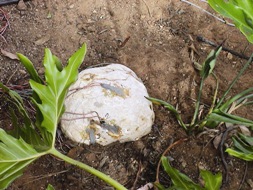
“Miking up” a rock
Eight Tee rosette Vishay strain-gauges (C2A-06-125LT-350) were bonded onto various sites on the face of this rock using the method and epoxy resin recommended by the gauge manufacturer. Next to each strain-gauge a thermocouple was also bonded onto the rock (Figure 2). They were then coated with 3145 RTV Protective Coating - a rubbery material to protect the gauges from direct contact with water (again, on the manufacturer’s recommendation). The rock was placed in one author’s garden, and exposed to the changing conditions of day and night (Figure 3).
Each gauge measured microstrain (change in length expressed in parts per million). One gauge from each rosette was chosen and attached to one of two Vishay P3 Strain Indicator and Recorder (each recorder had four channels). The microstrain from each strain gauge was recorded every five minutes. The temperature at the site of each strain gauge was also recorded every five minutes using a PICO TC-08 thermocouple data logger.
Channels 1,2,3 and 4 were on the exposed surface and channels 5, 6, 7, and 8 on the buried surface of the rock. Data from each channel were downloaded into a Microsoft Office Excel worksheet. This was converted from an .xls file to a .wav file using Matlab software. Matlab enables the user to specify the sampling frequency of the sequence of samples to be recorded as an audio WAV file.
As mentioned before, the basic frequency of one cycle per 24 hours has to be increased to somewhere within the human hearing range of 20-20,000 Hz. The original signal was sampled at a rate of 12 samples per hour, or 288 samples per day. The sampling frequency for the WAV files was specified as 10KHz, i.e., increasing the sampling rate from one every five minutes to 10,000 per second, speeding up the “sound” by a factor of 3,000,000 . The resultant audio frequency of the WAV files was 10,000/288=34.7 Hz. The “.WAV” files for each individual channel and a combined “.WAV” file of all the channels for the first six months (Dec 2005 to June 2006) accompany this article (Audio Files 1-12).